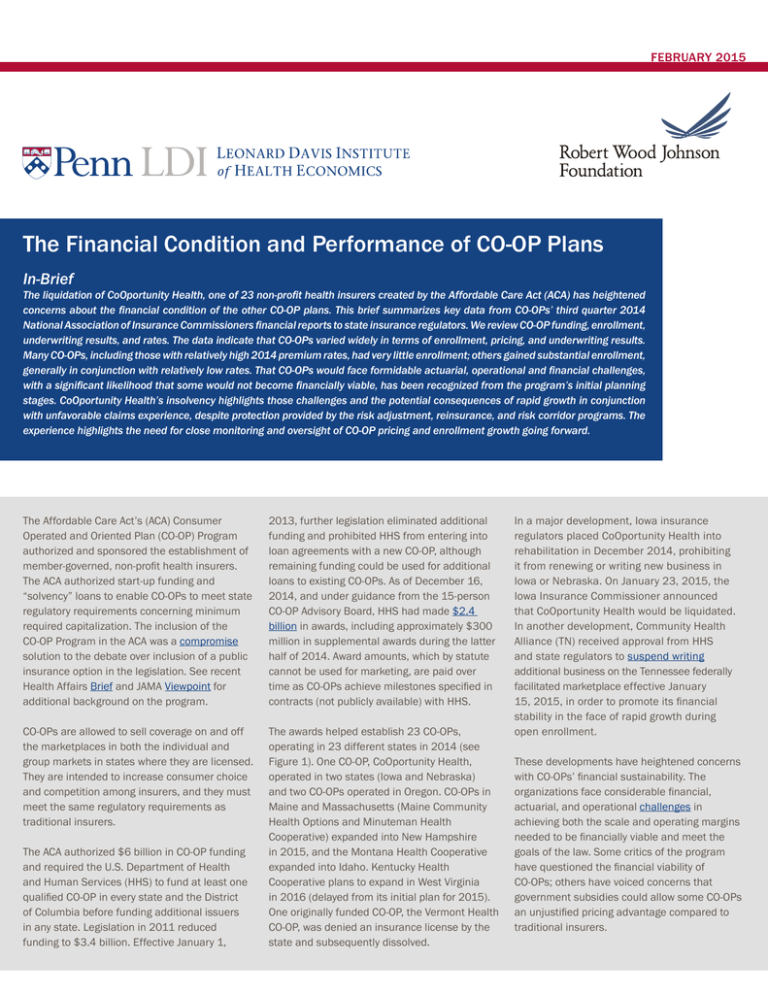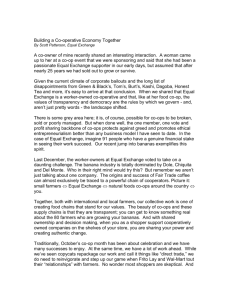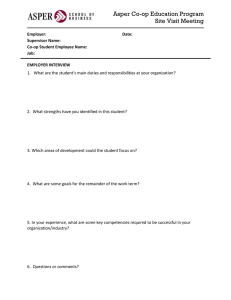The Financial Condition and Performance of CO-OP Plans
advertisement

FEBRUARY 2015 The Financial Condition and Performance of CO-OP Plans In-Brief The liquidation of CoOportunity Health, one of 23 non-profit health insurers created by the Affordable Care Act (ACA) has heightened concerns about the financial condition of the other CO-OP plans. This brief summarizes key data from CO-OPs’ third quarter 2014 National Association of Insurance Commissioners financial reports to state insurance regulators. We review CO-OP funding, enrollment, underwriting results, and rates. The data indicate that CO-OPs varied widely in terms of enrollment, pricing, and underwriting results. Many CO-OPs, including those with relatively high 2014 premium rates, had very little enrollment; others gained substantial enrollment, generally in conjunction with relatively low rates. That CO-OPs would face formidable actuarial, operational and financial challenges, with a significant likelihood that some would not become financially viable, has been recognized from the program’s initial planning stages. CoOportunity Health’s insolvency highlights those challenges and the potential consequences of rapid growth in conjunction with unfavorable claims experience, despite protection provided by the risk adjustment, reinsurance, and risk corridor programs. The experience highlights the need for close monitoring and oversight of CO-OP pricing and enrollment growth going forward. The Affordable Care Act’s (ACA) Consumer Operated and Oriented Plan (CO-OP) Program authorized and sponsored the establishment of member-governed, non-profit health insurers. The ACA authorized start-up funding and “solvency” loans to enable CO-OPs to meet state regulatory requirements concerning minimum required capitalization. The inclusion of the CO-OP Program in the ACA was a compromise solution to the debate over inclusion of a public insurance option in the legislation. See recent Health Affairs Brief and JAMA Viewpoint for additional background on the program. 2013, further legislation eliminated additional funding and prohibited HHS from entering into loan agreements with a new CO-OP, although remaining funding could be used for additional loans to existing CO-OPs. As of December 16, 2014, and under guidance from the 15-person CO-OP Advisory Board, HHS had made $2.4 billion in awards, including approximately $300 million in supplemental awards during the latter half of 2014. Award amounts, which by statute cannot be used for marketing, are paid over time as CO-OPs achieve milestones specified in contracts (not publicly available) with HHS. CO-OPs are allowed to sell coverage on and off the marketplaces in both the individual and group markets in states where they are licensed. They are intended to increase consumer choice and competition among insurers, and they must meet the same regulatory requirements as traditional insurers. The awards helped establish 23 CO-OPs, operating in 23 different states in 2014 (see Figure 1). One CO-OP, CoOportunity Health, operated in two states (Iowa and Nebraska) and two CO-OPs operated in Oregon. CO-OPs in Maine and Massachusetts (Maine Community Health Options and Minuteman Health Cooperative) expanded into New Hampshire in 2015, and the Montana Health Cooperative expanded into Idaho. Kentucky Health Cooperative plans to expand in West Virginia in 2016 (delayed from its initial plan for 2015). One originally funded CO-OP, the Vermont Health CO-OP, was denied an insurance license by the state and subsequently dissolved. The ACA authorized $6 billion in CO-OP funding and required the U.S. Department of Health and Human Services (HHS) to fund at least one qualified CO-OP in every state and the District of Columbia before funding additional issuers in any state. Legislation in 2011 reduced funding to $3.4 billion. Effective January 1, In a major development, Iowa insurance regulators placed CoOportunity Health into rehabilitation in December 2014, prohibiting it from renewing or writing new business in Iowa or Nebraska. On January 23, 2015, the Iowa Insurance Commissioner announced that CoOportunity Health would be liquidated. In another development, Community Health Alliance (TN) received approval from HHS and state regulators to suspend writing additional business on the Tennessee federally facilitated marketplace effective January 15, 2015, in order to promote its financial stability in the face of rapid growth during open enrollment. These developments have heightened concerns with CO-OPs’ financial sustainability. The organizations face considerable financial, actuarial, and operational challenges in achieving both the scale and operating margins needed to be financially viable and meet the goals of the law. Some critics of the program have questioned the financial viability of CO-OPs; others have voiced concerns that government subsidies could allow some CO-OPs an unjustified pricing advantage compared to traditional insurers. 1 FEBRUARY 2015 Figure 1. States with a Consumer Operated and Oriented Plan (CO-OP) VT WA NH ME ND MT MN OR MI WY IA IL CO MO KS CA NJ OH IN DE WV UT RI CT PA NE NV MA NY WI SD ID VA MD KY NC DC TN SC AR OK AZ NM MS AL CO-OP GA CO-OP in 2015 LA TX CO-OP in 2016 AK FL None HI Source: CCIIO (http://www.cms.gov/CCIIO/Resources/Grants/new-loan-program.html) This brief summarizes data on CO-OP funding, enrollment, and underwriting experience as reported in CO-OPs’ third quarter 2014 National Association of Insurance Commissioners (NAIC) financial reports to state insurance regulators. It also provides background on levels of CO-OP marketplace rates in 2014 versus traditional insurers using the RWJF HIX Compare data, and it summarizes CO-OPs’ rate changes using 2015 rate filings in states with available data. FUNDING Figure 2 shows CO-OP award amounts reported by HHS as of December 16, 2014, and the amounts paid and reported as start-up loans and solvency loans in CO-OPs’ September 30, 2014 NAIC financial statements (including in some instances funding received after September 30, but before the statements were filed with regulators). The figure excludes Freelancers COOP of New Jersey (doing business as Health Republic Insurance of New Jersey), which had a $109 million award, but for which 2014 financial statements were not available. Start-up loans were reported as “borrowed money” in insurers’ financial statements. In some cases, the amounts shown in that category may include small amounts of borrowing from other sources. In order to meet state solvency requirements, solvency loans were structured as “surplus notes.” Surplus notes require regulatory approval of any repayments and are treated as “capital and surplus” rather than debt in insurers’ regulatory financial statements, thus enabling CO-OPs to meet regulatory capital and surplus requirements. The gap between the total award and the sum of borrowed money and surplus notes represents award not yet advanced. Approximately $300 million of additional awards were made from September 26 through December 16, 2014, including $91 million to Freelancers Health Services (NY, doing business as Health Republic Insurance of New York), $66 million to Minuteman Health (MA), $65 million to Kentucky Health Cooperative (KY), $51 million to Common Ground Healthcare Cooperative (WI), and $48 million to HealthyCT (CT). CoOportunity Health (IA, NE) was awarded an additional solvency loan in the amount of $32.7 million on September 26, 2014, and it issued a surplus note in that amount on November 14, which was included in its September 30 financial statement. HHS denied the company’s subsequent request for additional funding prior to its takeover by regulators. Start-up loans are for five year terms from each draw with repayment in a lump sum or per an agreed schedule. The required interest rate is the lesser of zero or the 5-year Treasury rate less one percentage point at the time of the award, which generally resulted in a zero rate. Solvency loans are for 15 years from each draw, again with repayment in a lump sum or per agreed schedule. The required interest rate is the lesser 2 FEBRUARY 2015 Figure 2. CO-OP Award Amounts (12/16/2014) and Drawdowns (9/30/2014) Arches Mutual Insurance Co.—UT Colorado Health Ins Coop Inc.—CO Common Ground Healthcare Coop—WI Community Health Alliance—TN Consumers' Choice Hlth Ins Co.—SC Consumers Mutl Ins of Michigan—MI CoOportunity Health—IA & NE Coordinated Health Mutual Inc.—OH Evergreen Health Coop Inc.—MD Freelancers Consumer Operated—OR Freelancers Health Svc Corp.—NY HealthyCT Inc.—CT Kentucky Health Coop Inc.—KY Land of Lincoln Mutl Hlth Ins—IL Louisiana Health Coop Inc.—LA Maine Community Health Options—ME Meritus Mutual Health Partners—AZ Minuteman Health Inc.—MA Montana Health Cooperative—MT Nevada Health CO-OP—NV New Mexico Health Connections—NM Oregon's Health CO-OP—OR $0 $50,000 Total Award $100,000 $150,000 Borrowed Money (Startup loans) $200,000 $250,000 $300,000 Surplus Notes (Solvency loans) Sources: Award amounts reported by CCIIO (http://www.cms.gov/CCIIO/Resources/Grants/new-loan-program.html). Borrowed money and surplus notes reported in insurers’ NAIC Health Quarterly Statement as of Septermber 30, 2014, obtained from SNL Financial. of zero or the average rate for 10- and 20-year Treasuries less two percentage points, which generally resulted in annual rates in the 0.25 percent to 0.4 percent range. As noted above, disbursements for both types of loans are based on achievement of specified operational and financial milestones. INDIVIDUAL AND GROUP MARKET ENROLLMENT HHS has not made public data on 2014 marketplace enrollment at the state-carrier level. According to anecdotal media reports and a document from the U.S. House Oversight Committee staff, over half of CO-OPs had 2014 enrollment much smaller than had been projected, while seven CO-OPs had enrollment much greater than projected. Figure 3 shows the total number of covered lives (members) reported in the CO-OPs’ September 30, 2014 financial statements (NAIC data unavailable for Health Republic Insurance of NJ, which according to New Jersey Department of Banking and Insurance data had about 2,500 marketplace enrollees and 3,700 total enrollees). The NAIC statements report separately for individual and group “comprehensive” medical coverage. (The detailed supplemental health exhibits required by the ACA are only prepared annually.) The enrollment counts aggregate marketplace and any off exchange coverage and, for group coverage, do not separate small group from large group coverage, if any. The aggregate reported enrollment in the September 30 statements is 521,000 members, consisting of 391,000 members in individual coverage and 123,000 group members. Seven CO-OPs reported at least 20,000 members as of September 30, and four had 40,000 or more. CoOportunity Health (IA, NE) reported over 91,000 members, with 53,000 and 38,000 in the individual and group markets respectively. Freelancers Health Services (NY) had 140,000 members, 3 FEBRUARY 2015 Figure 3. Reported CO-OP Enrollment as of 9/30/2014 Arches Mutual Insurance Co.—UT Colorado Health Ins Coop Inc.—CO Common Ground Healthcare Coop—WI Community Health Alliance—TN Consumers' Choice Hlth Ins Co.—SC Consumers Mutl Ins of Michigan—MI CoOportunity Health—IA & NE Coordinated Health Mutual Inc.—OH Evergreen Health Coop Inc.—MD Freelancers Consumer Operated—OR Freelancers Health Svc Corp.—NY HealthyCT Inc.—CT Kentucky Health Coop Inc.—KY Land of Lincoln Mutl Hlth Ins—IL Louisiana Health Coop Inc.—LA Maine Community Health Options—ME Meritus Mutual Health Partners—AZ Minuteman Health Inc.—MA Montana Health Cooperative—MT Nevada Health CO-OP—NV New Mexico Health Connections—NM Oregon's Health CO-OP—OR 0 20,000 Individual 40,000 60,000 80,000 100,000 120,000 140,000 160,000 Group Source: Insurers’ NAIC Health Quarterly Statement as of September 30, 2014, obtained from SNL Financial. including 87,000 in the individual market. Kentucky Health Cooperative reported 57,000 members, and Consumers’ Choice Health Insurance (SC) reported 48,000 members, all with individual coverage. Calculating CO-OP market shares for marketplace, off exchange, total individual, and group coverage is infeasible with available data. In addition to not reporting marketplace versus off exchange enrollment, health insurers’ regulated quarterly financial statements do not report data at the state level (unless the company only operates in one state, in which case the total reported is for that state, as is true for all CO-OPs in 2014 except CoOportunity Health). Comparison of CO-OP reported individual market enrollment as of September 30 to aggregate counts of persons at the state level who had selected a marketplace plan as of April 2014 (the last reported data, not shown) is consistent with miscellaneous media reports that CO-OPs were dominant marketplace players in Iowa, Nebraska, Maine, and Kentucky, with sizable market shares in in New Mexico, New York, and South Carolina. Figure 4 shows information on CO-OP premium rates versus non CO-OPs in 2014. For each CO-OP state, the RWJF HIX Compare data were used to calculate the CO-OP’s “relative rate” as the percentage difference between the CO-OP’s average Silver Plan premium for a single, 27 year old in the state to the corresponding average premium for all other carriers operating in the same rating areas. The relative rates shown in Figure 4 indicate substantial variation in CO-OP pricing across states. Comparing Figures 3 and 4, CO-OPs with at least 20,000 individual members as of September 30, 2014 (six CO-OPs operating in seven states) had lower than average rates. In contrast, the CO-OPs with low 2014 enrollment generally had higher than average rates. Only Minuteman Health (MA) had a lower-than-average rate and negligible enrollment. The company’s low enrollment despite relatively low rates has been attributed in part to technical problems that plagued enrollment into the Massachusetts marketplace. Figure 4 also shows average percentage individual market rate changes for 2015 versus 2014 for CO-OPs in states with publicly available data on carriers’ 2015 rate filings as of November 2014. (Pricing data for 2015 for states with federally facilitated marketplaces now available here; RWJF HIX Compare data for 2015 for states with state-based marketplaces now available here; also see ProPublica rate data.) Consistent with anecdotal reports for other (non CO-OP) carriers, Figure 4 shows a clear tendency for CO-OPs with higher-than-average 2014 rates to reduce 2015 rates, while the three CO-OPs with the largest 2014 enrollment and relatively low 2014 rates each raised 2015 rates by more than 10%. 4 FEBRUARY 2015 Figure 4. CO-OP 2014 Rates Relative to Non-CO-OP State Average and CO-OP 2015 Rate Changes Arches Mutual Insurance Co.—UT Colorado Health Ins Coop Inc.—CO Common Ground Healthcare Coop—WI Community Health Alliance—TN Consumers' Choice Hlth Ins Co.—SC Consumers Mutl Ins of Michigan—MI CoOportunity Health—IA CoOportunity Health—NE Coordinated Health Mutual Inc.—OH Evergreen Health Coop Inc.—MD Freelancers & Oregon’s Health CO-OP Freelancers Co-op of NJ—NJ Freelancers Health Svc Corp.—NY HealthyCT Inc.—CT Kentucky Health Coop Inc.—KY Land of Lincoln Mutl Hlth Ins—IL Louisiana Health Coop Inc.—LA Maine Community Health Options—ME Meritus Mutual Health Partners—AZ Minuteman Health Inc.—MA Montana Health Cooperative—MT Nevada Health CO-OP—NV New Mexico Health Connections—NM -30% -20% -10% 0% Relative Rate 2014 10% 20% 30% 40% 50% 60% 70% 80% Rate Change 2015 Source: Relative rate in 2014 calculated by author using RWJF HIX Compare data for 2014. Rate change for 2015 obtained from insurer’s rate filings with state regulators. UNDERWRITING RESULTS Figure 5 shows CO-OPs’ ratios to reported premiums of reported medical claims, claim adjustment expenses, and general expenses (for administrative, marketing, premium taxes, and overhead) using data from the NAIC statements for the first three quarters of 2014. (Insurers’ quarterly NAIC financial statements do not provide the detail necessary to calculate ACA medical loss ratios with quality expense and tax/fee adjustments that are reported annually in the NAIC Supplemental Health Exhibits.) The results are for individual and group coverage combined. The ratios reported in Figure 5 reflect estimates of recoveries and payments from the ACA’s risk-sharing programs (temporary reinsurance, temporary risk corridors, and permanent risk adjustment). Specifically, the claim amounts used to calculate the ratios in Figure 5 are net of estimated recoveries from the ACA’s temporary reinsurance program, and premiums are net of assessments paid to that program (except for the portion allocated to the U.S. Treasury, which is included in general expenses). Premiums reflect the insurers’ estimates, if any, of the amount of money expected from the risk adjustment and risk corridor programs for experience up to the report date. About a third of the CO-OPs reported estimated recoveries from risk adjustment; another third reported estimated recoveries from the risk corridor program. No CO-OP reported any estimated net payments to those programs. In total, the CO-OPs reported $164 million of estimated risk corridor recoveries, representing 11.8% of the $1,387 million in reported premiums including risk sharing recoveries, and $90 million of risk adjustment recoveries (6.5% of reported premiums including risk sharing recoveries). CoOportunity Health (IA & NE) and Common Ground Healthcare 5 FEBRUARY 2015 Figure 5. Medical Claims, Claim Adjustment Expense, and General Expense to Premiums after Estimated Risk-Sharing through 9/30/2014 Arches Mutual Insurance Co.—UT Colorado Health Ins Coop Inc.—CO Common Ground Healthcare Coop—WI Community Health Alliance—TN Consumers' Choice Hlth Ins Co.—SC Consumers Mutl Ins of Michigan—MI CoOportunity Health—IA & NE Coordinated Health Mutual Inc.—OH Evergreen Health Coop Inc.—MD Freelancers Consumer Operated—OR Freelancers Health Svc Corp.—NY HealthyCT Inc.—CT Kentucky Health Coop Inc.—KY Land of Lincoln Mutl Hlth Ins—IL Louisiana Health Coop Inc.—LA Maine Community Health Options—ME Meritus Mutual Health Partners—AZ Minuteman Health Inc.—MA Montana Health Cooperative—MT Nevada Health CO-OP—NV New Mexico Health Connections—NM Oregon's Health CO-OP—OR 0% 100% 200% Medical Claims/Premiums 300% 400% 500% Claim Adjustment/Premiums 600% 700% General Expense/Premiums Source: Author’s calculation using data reported in insurers’ NAIC Health Quarterly Statement as of September 30, 2014, obtained from SNL Financial. (WI) accounted for over half of the reported estimates for risk corridors and risk sharing. State regulators authorized insurers to include estimated risk-sharing revenues (and any payments) in reported income, assets, and liabilities for 2014 financial reports. The efficacy of that treatment for risk adjustment and risk corridors was debated extensively by regulators in 2014 in view of uncertainty in the amounts ultimately to be received or paid and the lags in receiving or making payments under the programs. The decision was made in December to continue allowing insurers to recognize estimated amounts in their financial statements going forward prior to their final determination and payment, provided that there existed a reasonable basis for estimation. Figure 5 shows substantial variation in underwriting results among the CO-OPs. Given start-up related expenses with a large fixed component, the general expense ratios are often very high for CO-OPs with little enrollment. The ratios to premiums of medical claims, claim adjustment expenses, and general expenses for CO-OPs combined for the first three quarters of 2014 were 91.7%, 3.8%, and 21.3%, respectively, producing a total ratio of costs to premiums of 116.8% (known as the “combined ratio” in insurance circles). That ratio corresponds to an underwriting loss (which does not consider a very modest amount of investment income) of about $17 per $100 of premiums (with premiums including estimated risk adjustment and risk corridor recoveries). Among the five CO-OPs with the largest enrollments, the combined ratio ranged from a high of 114.5% for CoOportunity Health (medical claims ratio of 100%), with Kentucky Health Cooperative a close second (combined ratio of 112.8%, medical claims ratio of 100%), to a low of 90.8% for Maine Community Health Options (medical claims ratio of 70.5%). COOPORTUNITY HEALTH CoOportunity Health’s founders included a former health insurance executive and a former Iowa insurance commissioner. The current Iowa insurance commissioner placed the company under regulatory supervision on December 16 after the Centers for Medicare & Medicaid Services indicated that it would not provide additional funding. The commissioner’s order emphasized the company’s rapidly declining cash position, and that by October 31, 2014 it had operating losses for the 6 FEBRUARY 2015 year of $45.7 million. The order also highlighted the insurer’s risk-sharing receivables of $125.6 million at that time, which would not be received until the latter half of 2015, including about $60 million in risk corridor receivables which might not be forthcoming due to restrictions on HHS funding of risk corridor payments included in the Consolidated and Further Continuing Appropriations Act of 2015 enacted by the Congress on December 13. The commissioner’s January 23rd announcement that the company would be liquidated indicated that it had insufficient funds to pay medical claims over the next six months. high medical costs in relation to premiums. In addition, both Iowa and Nebraska permitted health insurers to renew plans that were not compliant with the ACA. That could have aggravated adverse selection if healthier-than-average consumers were more likely to renew non-compliant plans. Gravitation of persons previously insured in the states’ high risk pools into marketplace plans could also have played a role, although both states’ pools had relatively small enrollments (around 3,000) at the end of 2013. Following the December announcement, Iowa and Nebraska regulators advised existing CoOportunity policyholders to switch insurers, and they repeated that advice in conjunction with the announcement of the decision to liquidate the company on January 23. Any of the company’s policies that remain in effect on March 1 will no longer be eligible for premium and cost-sharing credits. Both Iowa and Nebraska have insurance guaranty associations that provide up to $500,000 in total protection per covered person to customers and providers if the company’s asset are unable to meet its obligations. As per the guaranty system statutes, any payments from the guarantee associations will be funded through assessments on surviving insurers in each state. CONCLUSION Rapid customer growth with inadequate prices and adverse claims experience has played a major role historically in insurance company insolvencies. One contributing factor in this instance was CoOportunity Health’s participation in Iowa’s alternative program for Medicaid expansion, in which eligible persons could purchase private coverage. The company announced in October its withdrawal from that program due to Data reported to state regulators for the first three quarters of 2014 indicate substantial variation in CO-OP performance. CO-OPs varied widely in terms of enrollment, pricing, and underwriting results. Many CO-OPs, including those with relatively high 2014 premium rates had very little enrollment; others gained substantial enrollment, generally in conjunction with relatively low rates. That CO-OPs would face formidable actuarial, operational and financial challenges, with a significant likelihood that some would not become financially viable, has been recognized from the program’s initial planning stages. CoOportunity Health’s insolvency highlights those challenges and the potential consequences of rapid growth in conjunction with unfavorable claims experience, despite protection provided by the risk adjustment, reinsurance, and risk corridor programs. The experience highlights the need for close monitoring and oversight of CO-OP pricing and enrollment growth going forward, including whether and when it could become desirable for managers and regulators to restrict additional enrollment that could threaten a CO-OP’s viability. About the Author This Data Brief was written by Scott E. Harrington, PhD, Professor of Health Care Management, and Insurance and Risk Management. The author thanks Janet Weiner for helpful comments; Ruchita Pendse and Chris Colameco provided excellent research assistance. About The Leonard Davis Institute of Health Economics The Leonard Davis Institute of Health Economics (LDI) is the University of Pennsylvania’s center for research, policy analysis, and education on the medical, economic, and social issues that influence how health care is organized, financed, managed, and delivered. LDI, founded in 1967, is one of the first university programs to successfully cultivate collaborative multidisciplinary scholarship. It is a cooperative venture among Penn’s health professions, business, and communications schools (Medicine, Wharton, Nursing, Dental Medicine, Law School, and Annenberg School for Communication) and the Children’s Hospital of Philadelphia, with linkages to other Penn schools, including Arts & Sciences, Education, Social Policy and Practice, and Veterinary Medicine. About the Robert Wood Johnson Foundation For more than 40 years the Robert Wood Johnson Foundation has worked to improve health and health care. We are striving to build a national Culture of Health that will enable all to live longer, healthier lives now and for generations to come. For more information, visit www.rwjf.org. Follow the Foundation on Twitter at www.rwjf.org/twitter or on Facebook at www.rwjf.org/facebook. 7




